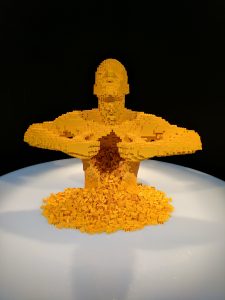This last weekend I experienced a rare event; a completely new form of art! In the exhibition, “The Art of the Brick,” we were treated to the genius of Nathan Sawaya, corporate lawyer turned Master Designer of Lego Sculptures. What I saw totally amazed, delighted and thrilled me. It seemed so obvious in retrospect, why hadn’t anyone before thought of making this kind of art entirely from Legos?
Individuals who push through the boundaries of commonly held ways of seeing and believing, inspire us.
We all have the ability to do so, but why don’t we do it more often? I believe it’s because of inertia. Our habits are comfy, like an old pair of slippers, into which we comfortably slip after a long, hard day on our feet.
Our highly organized bureaucracies of attitudes, beliefs and actions were formed in response to needs in our past. They served us at one time, yet we still cling to them as if they are the core of who we are now. The clinging often gets in our way of doing what in retrospect, might seem obvious. Even if it’s something we truly want.
This reminds me of several clients who struggle with making that big leap forward in the realm of leadership. Going from what they’ve always done, to what they’ve never done feels awkward and even scary. Transitioning from being Founders who are accustomed to staying in the weeds and pushing the troops uphill to being a CEO who leads from in front requires a disruption of the bureaucracies of habit.
Intellectually, leaders often know “what got me here won’t get me there.”
Where they struggle is often “what do I need to do instead?”
I believe it begins by disrupting the ways in which they have seen their roles and their capabilities. It’s hard to inspire others when you are used to having everyone run everything by and through you. The first step is for leaders to learn to let go of seeing themselves and others as immovable. Believe in your capacity to change, and be willing to have support until the change has taken root.
I always ask about care: “for the sake of what would you be willing to change?” A big vision can help pull people into otherwise uncomfortable territory. However, vision alone is not enough. It takes movement and action. As we all know, habits can be difficult to change on one’s own.
Consider people who inspire you. Reflect on people who have disrupted habitual ways of seeing and thinking about their worlds. Ask the same of yourself. What pattern, if I disrupted it, could change my way of seeing, and help me on the path to leading others?



